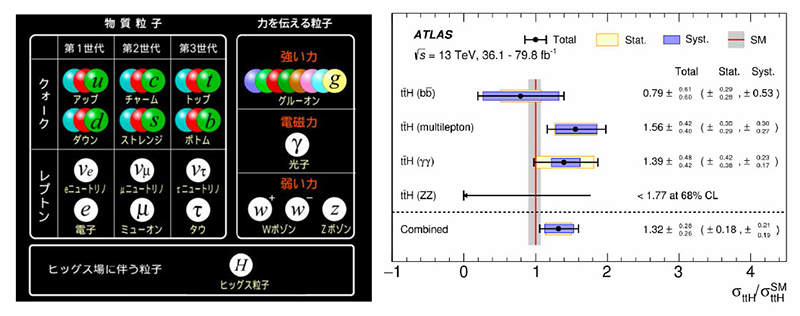* CERN has recently issued a press release regarding the results of experiments including the LHC-ATLAS Experiment.
The University of Tokyo research group (with roughly 30 members, both faculty and graduate students) is taking part in the international experiment, with Director Asai as a co-representative of the Japanese group.
High Energy Accelerator Research Organization
The University of Tokyo
ATLAS Japan Group
Key points of these results
- The experiment achieved the first observation of the Higgs boson production in association with a top quark pair, which is an extremely rare elementary particle interaction.
- The observed cross section is consistent with the bounds of statistical error and matches Higgs mechanism predictions, suggesting that the mass of top quark is generated by the Higgs mechanism.
- Past observations suggested that the mass of bottom quark and tau lepton are generated by the Higgs mechanism. Based on the results, it would be fair to say that the origin of the third-generation fermion (matter particle) has been elucidated.
Contents of announcement
Overview
On June 4, at 2:00 p.m. (local time), the European Organization for Nuclear Research (CERN) issued a press release regarding the results from ATLAS and CMS experiments at the Large Hadron Collider (LHC). In the Japanese version of the press release, KEK and the University of Tokyo, the main members of the ATLAS Japan Group taking major role in the LHC-ATLAS measurement, provided additional information regarding the experiment.
The CERN press release states that data from experiments such as the ATLAS Experiment provides a direct evidence of an interaction between Higgs boson and top quark, which is the most massive elementary particle. Specifically, it observed, with a statistical significance of 6.3 standard deviations, the extremely rare events of Higgs bosons being created together with pairs of top quarks. The probability of the event matches the prediction of the Higgs mechanism. This indicates that the mass of top quark, which is the most massive quark, several orders of magnitude greater than other elementary particles, is generated by the same mechanism. This shows that the Higgs mechanism is not only responsible for the mass of elementary particles that convey force, but those that form matter as well. This is a significant milestone in achieving a full understanding of the Higgs mechanism.
This measurement also has the potential for exploring new particles. The quantum theory allows a possibility of extremely massive particles being generated and annihilated in extremely short periods of time in the interaction of fundamental particles. If there are any extremely massive, unknown particles that react with Higgs bosons, they could intervene in these rare interactions, and the probabilities could differ from Higgs mechanism predictions. With larger set of data in the future, inconsistency between the measurement and the prediction could be observed, which would indicate indirect observation of these new particles.
The ATLAS Experiment is a major project, with 3,000 researchers from 38 countries. This includes roughly 150 researchers and graduate students from 17 Japanese institutions. All members of the experiment aim to discover new elementary particle physics which go beyond the Standard Model. These new results have been published in several papers by ATLAS collaboration.
Furthermore, from June 11 to June 15, "The ATLAS Overview Week" will be held at International Conference Center Masaru Ibuka Auditorium in the Waseda University, located in Shinjuku-ku, Tokyo. More than 300 ATLAS collaborators attended the international conference, and discussed the results of these research. The conference is held three times per year to discuss ATLAS Experiment findings and future direction, and this marks the first time that the conference is held in Asia.
Background
The LHC is the world's highest energy particle collider. The circular accelerator collides protons accelerated to almost the speed of light. It began operation in 2009, and from March 2010 began performing full-fledged experiments with collision energies of 7 TeV (teraelectronvolts). In April 2012, the collision energy was increased to 8 TeV, and on July 4, the Higgs boson was observed for the first time. The LHC is currently gathering data with collision energies of 13 TeV, and ATLAS experiment is collecting data to perform precise measurements of the interactions between elementary particles and Higgs bosons to elucidate the origin of mass, also to search for new particles that could point the way to new physical phenomena.
Research and results
Evidence was discovered in the data collected up until 2017 of the extremely rare interaction of Higgs bosons and pairs of top quarks being generated simultaneously. Higgs bosons are generated by collisions by protons and immediately after being generated decay into pair of various fundamental particles. With these were being categorized, analysed, and summarized, the interaction was discovered, and the statistical significance of 6.3 standard deviations indicates that it was not an error. At the current level of measurement accuracy, the probability of the event rate matches the predictions from the Higgs mechanism, suggesting that the mass of top quark is generated by the dynamical properties of Higgs fields (=Higgs mechanism).
Significance and future of this research
Since the discovery of the Higgs boson in 2012, it has been determined that the universe we live in is not empty, but is filled by the Higgs fields, and that the mass of elementary particles is generated by the dynamic properties of these Higgs fields (=Higgs mechanism). At the same time, the experiment verified the masses of W and Z bosons, particles which mediate the transfer of force, are also created by the Higgs mechanism. From this point onwards, the key issue in the elementary particle physics was if the Higgs mechanism would be responsible for the masses of the particles that make up matter.
There are three generations of elementary particles that make up matter. Top quark is third-generation elementary particle. Past experimental results have suggested that the mass of other third-generation particles, bottom quark and tau lepton, are generated by the Higgs mechanism. Given the results, it would be fair to say that the Higgs mechanism has been identified as the mechanism by which mass is created for all third-generation material particles other than tau neutrino, which is difficult to perform verification for. This is a major step forward in gaining a comprehensive understanding of the origin of elementary particle mass.
In the elementary particle physics, reasons for the huge differences in the masses of particles that make up matter, and the causes of the differences in generations, are great mysteries. Research groups will investigate the interactions between top quark and Higgs bosons in depth, as well as expanding the research scope to also include second-generation material particles, as they try to solve the "generation mystery" (the reason for the existence of the three generations), one of the mystery of the elementary particle physics.
●CERN press release information:
CERN Press Release, The Higgs boson reveals its affinity for the top quark(related site)
●Comments from the ATLAS Collaboration:
ATLAS Press Statement, ATLAS observes direct interaction of Higgs boson with top quark(related site)

(Right) Comparison of the measured event rate on the Higgs associated production with top quark pair and prediction from the Higgs mechanism
